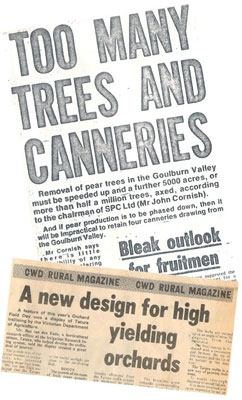The Tatura Trellis celebrated its 40th birthday recently, having been born under extra-ordinary circumstances in July 1973.
Declining export markets, high inflation, poor returns, low yields, reconstruction schemes, tree-pull schemes, waterlogging—this was the depressing jargon of the fruit industry in the early 1970s.
The export of canned fruit from Australia was going through the worst period in recent history. Our largest export market, the United Kingdom, joined the European Union.
Rampant inflation in Australia and depressed export markets caused the four canneries to resort to a tree-pull scheme, and it was suggested that the industry be rationalised.
Many orchardists in the Goulburn Valley faced ruin due to increased global competition, gross mismanagement of the economy, escalating inflation, cost increases of 70 per cent; and excessive rain which killed thousands of peach trees.
The canneries suggested that 2000 hectares of pear trees, or more than half a million trees be removed as quickly as possible.
Sweeping changes needed
Sweeping changes were needed to make fruit growing viable in the future.
Plenty of people considered the future of the fruit industry from the point of view of marketing, and the need to rationalise production. But that was not the only crisis. The orchardist could no longer absorb increasing costs.
The cost-saving approach—which orchardists were using to keep their heads above water—was merely postponing the inevitable.
Orchardists often failed when they tried to incorporate new ideas that could increase yields into existing systems of orchard management because the new systems were too difficult to manage, and still were not highly profitable.
Science and tree growth
The saying, Adversity is the Mother of Invention could be applied to the Tatura Trellis.
In the early 1970s, scientists at the Tatura Research Institute were well aware of the problems that confronted orchardists.
Plant physiologists studied how peach trees allocated their photosynthetic resources to fruit and vegetative growth (leaves, limbs, branches and roots).
The plant physiologists found for instance, that fruit and leaves were poorly distributed in free-standing and widely-spaced peach trees with most of the fruit on laterals that were up to one metre away from the leaves that captured most of the sunlight.
Because the trees were heavily shaded, the fruiting zones gradually moved to the upper part of the trees. Orchardists were growing more wood than fruit.
Trees needed to be closely planted and the architecture of the tree needed to be radically changed to obtain early yields, sustained high yields per hectare, and for mechanisation.
Science and soils
At the same time, soil scientists and irrigation experts at the Tatura Research Institute grappled with waterlogged soil, and aimed to improve soil structure, drainage and irrigation.
Deep ripping, applied gypsum, hilled-up top soil, and ryegrass grown in winter to maintain good structure of the top soil, became known as the Tatura System of Soil Management.
Methods of irrigation changed from flood or furrow irrigation to pipe-and-riser then to low-flow irrigation (drip or microjet).
A mechanical harvester was imported from California to determine factors of the tree and fruit that caused fruit to be damaged when mechanically harvested from large free-standing peach trees.
Blueprint for efficient orchard
In 1973 the time was ripe to combine the different fields of expertise to develop a blueprint of a modern and efficient orchard system.
One for the orchardist to follow throughout the life of the planting.
The blueprint was to integrate tree density, arrangement of trees, and training and pruning to maintain the desired configuration.
Added to this was soil management to maintain optimum growing conditions, efficient use of water for irrigation, use of irrigation water to manipulate growth and cropping, mechanical harvesting of the crop, mechanical trimming of the canopy in summer, designing special equipment to apply sprays efficiently, and an economic evaluation.
The blueprint also included the development of cheap methods for orchardists to propagate their own canning peach and pear trees from cuttings.
This type of research became known as systems research because knowledge from various disciplines was integrated to form the Tatura Trellis.
Tree design
(continued next issue)
For more information, see Tree Fruit November 2013






















